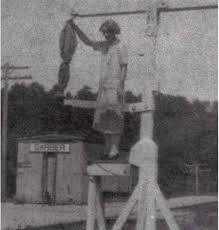Ghost towns are not all that uncommon and can be found in all fifty states and around the world. West of the Mississippi hundreds of towns sprang up in response to western expansion, gold strikes, water sources and railroads. Just as many disappeared seemingly overnight, left to decay and to be seen by only a few curious hikers or historians. An unseasonably warm January day and an opportunity to get off road in my FJ Cruiser led my wife and I to explore the ruins of two area ghost towns here in the Ozarks, Melva and Garber, Missouri.
There are striking similarities to these two abandoned towns. Both were rail communities. Both had a train station made from a converted rail car. Both bordered creeks, Turkey Creek in Melva and Roark Creek in Garber. One became famous for its inhabitants who were immortalized in literature, the other for unthinkable tragedy. Both are forever linked in Ozarks folklore.
Our first stop was Garber. A little web research provided us a map of the city as it stood in 1919, and some valuable research from the White River Valley Historical Society gave us some great historical background. You can read the fascinating story of Garber here http://thelibrary.org/lochist/periodicals/wrv/v4/n6/w71b.htm and here http://gchudleigh.com/garber.htm
The ruins of Garber are a nice hike from the Stonebridge golf course and development. Even with the aid of a satellite map we didn’t find it right away despite the fact that the winter season had denuded the trees. Only the old post office remains standing. Originally built in 1927 as a church it only held one religious service, the funeral of postmistress Ada Clodfelter. Ada was the proprietor of the general store that housed the original post office, When a mail clerk was caught stealing she phoned the authorities but before they could arrive he burned the store to the ground. Thus the new church became the new post office. 
Garber became something of a tourist attraction after the publication of Harold Bell Wright’s wildly successful novel “The Shepherd of the Hills.” The characters of Old Matt and Aunt Molly were directly created based on the citizens of Garber. But Garber was a “flag stop” and not a regular rail destination unlike Branson and Hollister, and eventually the remote town began to fade away. Many folks say that the idea for the theme park Silver Dollar City came after Pete Herschend visited the deteriorating town in the 1950’s. The old post office itself has been used as a dump, probably by an enterprising bathroom redecorator judging from the number of bathtubs at the site.
Garber was a few miles west of Branson, which was a very small town indeed before tourism took hold but still a major rail stop between Harrison, Arkansas and Springfield, Missouri. South of Branson on the railway was Hollister, then the tiny community of Melva. The town was populated by bridge workers for the railroad, loggers, orchard-tenders and those who worked in the numerous lead mines that dotted the area. There was a school, the Buell Hotel, a rail station (made from a re-purposed rail car as in Garber) and a Presbyterian missionary named Lucy Woods. A harrowing account of the tornado that destroyed the town can be found here http://thelibrary.org/lochist/periodicals/wrv/v1/N9/F63d.htm This is the best history of Melva that I have found and once again it was through the White River Valley Historical Society.
The story goes that Mrs. Buell ran from the hotel to the home of Lucy Woods and together they took shelter inside the fireplace which undoubtedly saved their lives. The sturdy fireplace still stands today. The hillside above the creek and railroad tracks was wiped clean of everything save the foundations of some of the buildings. Photos show even the trees and vegetation were carried away. Today scrub oaks and pines have sprouted back up on the once-ravaged hill obscuring the footprint of the once-thriving community. 11 people died, 8 of them children, and there was little urge to rebuild the town. Most moved on to Hollister and Branson and as the lead mines closed the remaining survivors just drifted away.
We finished our exploration by driving the rugged ATV trails in our FJ Cruiser to the Half Moon Mine and Alf Bolin cave just a few short miles away on the same large parcel of land near the Branson Airport. The history of Alf Bolin and a trip to the Murder Rocks is fodder for a future blog.
Here’s an interesting feature the local NBC affiliate did on Melva last year http://www.ky3.com/news/local/Ghost-town-is-hidden-in-Ozark-Mountain-foothills/-/21048998/21281450/-/u2gcpv/-/index.html
Melva and Garber are but two forgotten communities with important historical significance here in the Ozarks. Know of other sites I might like to explore? Reply in the comments section of this blog and let me know, I’m always on the hunt for old schoolhouses and ghost towns.








